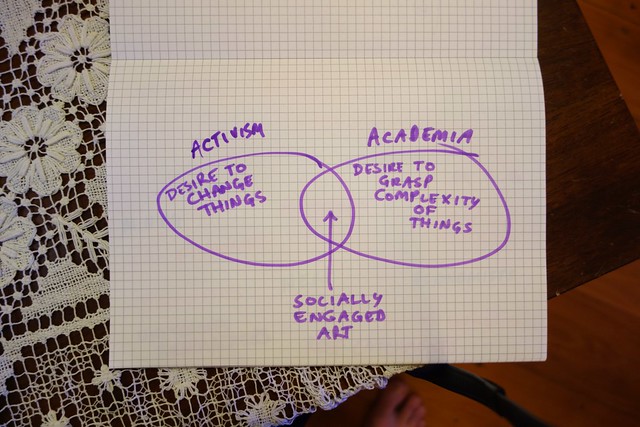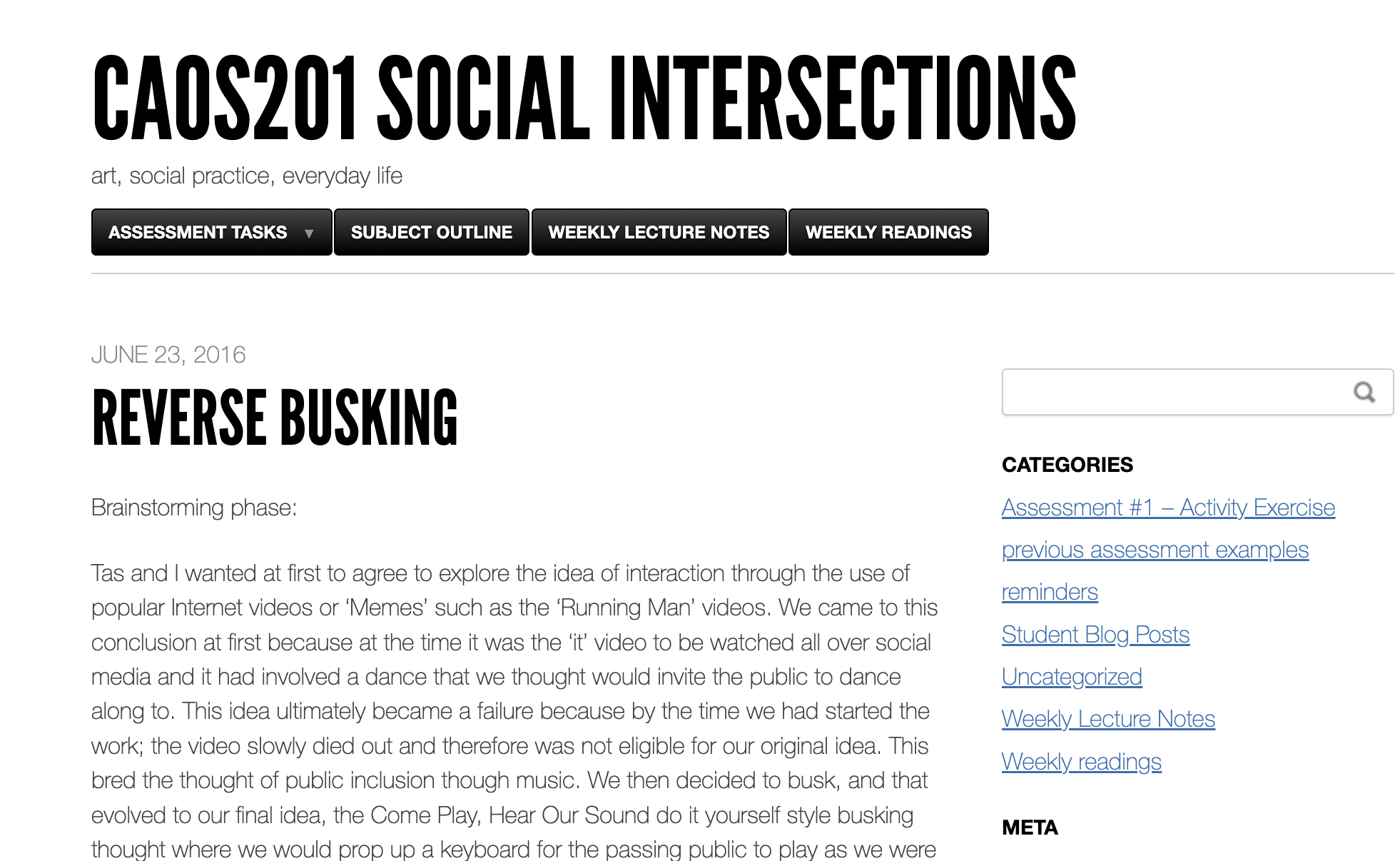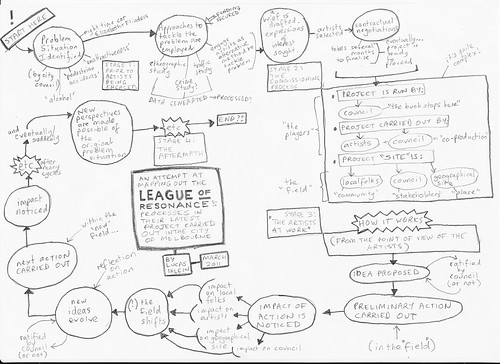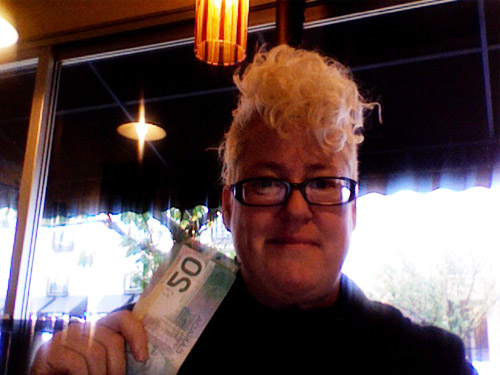Here’s a link to the Environmental Audit artist book.
An artist book drawn from the Environmental Audit project by Lucas Ihlein, at Museum of Contemporary Art, Sydney, 2010. This artist book was published to coincide with the exhibition “Diagrammatic: Works by Lucas Ihlein and Collaborators”, curated by Jasmin Stephens, Deakin University Art Gallery, 11 April – 18 May 2018, supported by the School of Communications and Creative Arts, Faculty of Arts and Education, Deakin University. Design by Fiona Hudson
Category Archives: Relational Aesthetics
Baking Dirt: Soil and the Carbon Economy

The Gold Coast, where Allan Yeomans works, is particularly vulnerable to sea level rise. See this map for a scenario based on a conservative rise of 110cm.
I’ve come from Wollongong to visit Allan Yeomans, the inventor of the Yeomans Carbon Still.
It seems fitting that Allan’s workshop is located here at the Gold Coast, where hundreds of skyscrapers cluster along the beach, perched barely above sea level. What will happen to this place in the near future, when sea levels rise up and flood the streets, and cyclones erode the foundations of the buildings? Will it become an unlivable ghost town?
Across the world, low-lying cities like the Gold Coast are ever more vulnerable to the effects of climate change, and Allan Yeomans hopes that his invention can help tackle this global problem.
Continue reading
Haiku and Socially Engaged Art
This week I was invited to participate in a one day public forum entitled “Live Art, Social & Community Engagement: Methodologies of Practice” at UNSW, convened by Stephanie Springger and Lenine Bourke.
Here’s how it worked:
In the morning, 5 artists gave brief presentations addressing key questions about the ethics and aesthetics of socially engaged art, community art, etc (the naming of these practices was also in question).
These artists were Leuli Eshragi, Latai Taumoepeau, Rosie Dennis, Cigdem Aydemir, and Lauren Booker, and their presentations were moderated by Francis Maravillas.
After lunch, each of the speakers was teamed up with a “live writer”. The live writers included Jennifer Hamilton, Rebecca Conroy, Keg de Souza, Astrid Lorange, and Lucas Ihlein. About 40 people were in attendance – from what I could gather, mainly artists, students, and curators. Around each pairing of speaker + live writer there was a breakout group to flesh out some of the salient points from the morning’s discussion.
The speaker led the small workshop discussion and the live writer used whatever method s/he felt most useful to map, transcribe, document etc what went on in the discussion. I was teamed up with Latai Taumoepeau, and our allocated theme was “class, negotiation and power”.
Many times in these kinds of events, I’ve used diagrams and mindmaps as a tool to make sense of the complexity of the discussion. However, this time I decided to try something different, proposing to use the Haiku form as a way to engage in live writing.
My previous experience with Haiku is minimal. I’m a fan of the great Japanese Haiku-ist Basho, and his “Oku no Hosomichi” aka “Narrow Road to the Deep North“. And I enjoyed John Cage’s translation of Basho’s Mushroom Haiku.
On the train up to the forum, I listened to a podcast I found by googling “socially engaged art” and “haiku”. It was by John Paul Lederach, and it was called “The Art of Haiku and the Soul of Peacebuilding”. Lederach is a “peacebuilder” who sometimes travels to places of deep conflict, and sits down with people to assist with the reconciliation process. In his talk, he says that he sometimes finds the Haiku form useful in crystallising complex ideas without requiring closure.
I found Lederach’s ideas inspiring, particularly his thoughts on the relationship between complexity and simplicity. He quotes a poem from Oliver Wendal Holmes Jnr:
I would not give a fig for the simplicity on this side of complexity
But I would give my life for the simplicity on the other side of complexity.
I found this interesting – often in my mindmaps and diagrams, I create an image of complexity. The graphic squiggles and vector lines are sometimes useful in explaining the intractable stuckness of a complex multi-stakeholder situation. But the Haiku has the potential to travel through this complexity “to the other side”.
What, Lederach asks, is simplicity on the other side of complexity? It’s a way of “finding the essence, while holding the complexity, and living into places that we don’t fully understand”. For Lederach, the Haiku can be a way of doing this. If the diagram breaks things down, the Haiku is about putting things together. He describes how sometimes he is able to practice a form of deep attentive listening at multi-party negotiations, where different positions are at odds with one another. At some point in the proceedings, somebody will say something which seems to rise with clarity from all the words. The Haiku at this moment writes itself. Then Lederach, when the time is right, reads the Haiku back to the group – and this is sometimes able to catalyse a deeper understanding within the group of the current dynamics of the relationship.
Back to the present. In our group discussion there were five of us: Latai, Pedro, Stella, Pippa and I. Francis and Stephanie also popped in briefly at different points. We didn’t even try to stick to the assigned subject of “class, negotiation and power”. If these issues were addressed it was part of an organic evolving conversation which was warm, probably assisted by the fact that there were only 5 of us.
Latai began by talking about some performances she has been doing – with fake spray-tan (at Gallery 4A in Sydney) and with white zinc cream (at the Hong Kong Basel Art Fair). She spoke about her choices of these darkening and lightening agents and their culturally specific meanings. While she spoke, I wrote my first haiku. A bit overwrought, but you’ve got to start somewhere:
What is light on one
Background can become very
dark on another.
While working on her spray-tan project, Latai had struck up a friendship with the proprietor of one particular company, “Black Magic”, who was so intrigued he decided to become a sponsor of the project:
Black Magic Spray Tan
Application by machine:
Darker and Darker.
Continuing her exploration of cultural identity and skin coloration, Latai told us how back in Tonga where she is “from”, her family members criticised her for being “too dark”. Perhaps it was the residue from her Spray Tan performance that made her darker, I can’t remember. Whatever the reason, her darker skin was regarded as being at odds with her privileged social status in the local community. Dark skin is associated with labourers and agricultural workers:
Skin colour darkens.
Relatives chastise me for
shellfishing all day.
Our conversation shifted to the Hong Kong Art Fair version of the work, where she used white zinc cream instead of spray tan – partly because of health and safety issues (the spray machine was not considered acceptable for the atmosphere of the indoor art fair environment). Latai didn’t know how to prepare for interacting with people in this strange setting:
Art fair audience:
How do they read all this stuff
Out of its context?
The audience for her work, Latai said, often shapes the kinds of performances she does. Sometimes, as a Pacific Islander, she receives invitations to perform in public under what she feels is an “anthropological gaze”. In these situations, she responds by performing unexpectedly – not merely doing a “nice ethnic dance”, but rolling herself up in long sheets of ceremonial cloth, writhing around, unravelling herself and
Fucking with my own
Material Culture. Fuck
Anthropologists!
At this point in the workshop, the other members of our group introduced ourselves. Stella, an artist and a recent masters graduate, is originally from Taiwan. In Taiwan, she told us, children are given English names. They do not get to choose. She was allocated “Betty”:
Taiwanese Betty.
Names distributed by force:
Betty for three years.
After three years, “Betty” decided to take the power back:
Recolonising
My own name. I choose Stella:
New identity.
Stella goes on:
Shared language shapes our
Collective memory. We
Can decolonise!
In her discussion of Taiwan, Stella mentions its other name: Formosa. I asked her about where that name came from, and what it means:
“Beautiful Island”.
Portuguese passing by shout
Out “Formosa Ho!”
Pippa, who works with the company Performing Lines, told us how she’d been in the UK for 14 years. She loves the context of “community art”, despite the fact that as a category of practice, it has been marginalised by the mainstream contemporary art world (this had been one of the contentious issues to come up in the plenary session of the morning):
Community Art.
Proudly looked down upon by
Snobbish Avant-Garde.
Pippa also made a strong case for consistency of language. She urged us to align the words we use in funding applications with the words we might use “on the ground” while doing community engaged projects. Too often, she said,
Funding proposals
Become marketing copy:
Bewildered people.
Pippa also argued that thousands of useful dollars get swallowed up when organisations have to pay large rents, and proposed that government funding should not be able to be spent on real estate:
Money should go to
People and Artists and not
To Bricks and Mortar.
This led to a discussion about how so many arts workers are chronically underpaid: clearly not a good thing. On the other hand, working beyond remuneration can sometimes generate more joy, because the time spent is not associated with a “job” and its demands for measurable outcomes. Questions arise:
Volunteerism:
Pleasure or exploitation?
And sub-contracting?
Pedro, who words for 4A Centre for Contemporary Art, had a lot to say about all of this. One of his main questions to me was about how as an artist I deal with the power and influence of the institution (in my case, embodied by my job at a university). It’s not an easy problem to negotiate – because when I’m embedded within an institution, potential projects tend to rise to the top of the pile only when they attract funding (whereas in my pre-institutionalised past I would have just done them “for free”). My response:
Institutional-
isation is a virus:
How to immunise?
Socially Engaged Art in a Venn Diagram

…first used in a presentation to the Mackay Local Marine Advisory Committee (LMAC) meeting, Great Barrier Reef Marine Park Authority, September 2014.
‘Socially Engaged Artists’ are people who…
‘Socially engaged artists’ are people who get to count as artists be virtue of their usual or self-defining artwork-making role within the artworld.
They then make use of this status (exploit it, if you like) by messing about in the real world outside the artworld, making things and doing things that they want people who normally would never go into an art gallery to look at and think about in the best sort of open-minded way in which people who do go into art galleries look at and think about things.
…that is to say, as sites of potential illumination (the acquisition of new memes) in any of the domains of human concern: moral, political, economical, scientific, legal, charitable, religious, and whatever. Even aesthetic illumination if there is such a thing (whatever, if anything, an aesthetic illumination may amount to that beats seratonin stimulators).
-Donald Brook, email to Lucas Ihlein, 14 September 2013.
“The Artist as…”

In 2012, together with m’colleague Brogan Bunt, I had the pleasure of creating and teaching a new subject at UOW called “Social Intersections“:
This subject examines how creative practice can engage with social forms and processes.
The aim is to encourage conceptually informed, interdisciplinary practice that reflects upon dimensions of social space and history. Students gain a critical understanding of relevant traditions of creative practice and develop individual and collaborative projects that reconsider the relationship between art and society.
The students did some really interesting projects and we had a bunch of excellent discussions in class about this “new” form of art, which engages with social relations as a material. We had good experiences with getting the students to use blogging to track their own progress throughout the semester.
I’m in the process of archiving the class blog, and clearing the decks so that in 2013, our new batch of students can start filling it up with their work.
I figured that some of the lecture notes from the subject might be more widely useful, so I’m cross-posting them on this here blog. Below I have cut and pasted an entry I wrote under the notional title of “Modes of Engagement”, which was intended to provide a cross-section (albeit incomplete) of ways in which artists might engage with the world, by acting “as” practitioners of other (non-art) disciplines…
Touchy Feely
Amy Spiers is an artist from Melbourne with an interest in participation and social engagement in art. She and Pip Stafford have curated a series of events and an exhibition in Hobart, in late January 2012, called Touchy Feely.
The preamble to Touchy Feely includes a series of questions which the participants hope to address:
- Should the “skill set” of art be instrumentalised to make a better world?
- Is there a role for hope, compassion and optimism in art, without having to take an evangelical or moralistic position?
- In our current situation, is it actually politically irresponsible to creatively express despair, unease and tension?
- Is contemporary art marked by a facile cynicism, heartlessness and nihilism?
- Or is relational and socially engaged art in Australia too sentimental, ethical and uncritical?
First of all, I want to say that it’s really great that artists are starting to draft up these kinds of questions about participatory, relational and socially-engaged art practices (or whatever else you want to call them). Hashing out the ethics and aesthetics of the work we do is an important step in “the maturing of the profession”, if you could call it that.
On the other hand, the first job of work to be done in answering these questions might be to rephrase them. For instance, “ethical” is strangely lumped in together with “sentimental” and “uncritical”; “cynicism” is likened to “nihilism”; and “hope” and “compassion” are cast as the opposites of “evangelism” and “moralism”. One of the tricky things for the participants in Touchy Feely might be to try and navigate their way through all this terminology without losing touch with the reality of actual projects. Perhaps a better way might be to dwell in the actuality of the work, and from there begin to reformulate these questions and assertions. Continue reading
Learning from Experience: in League with the City of Melbourne
The following essay was commissioned in early 2011, by the League of Resonance – a Melbourne artist group comprising Jason Maling, Jess Olivieri and Sarah Rodigari. In this piece, I try to tease out an anatomy of sorts for their particular brand of socially engaged art practice. Much of the underlying information comes from an interview I did with the artists in early 2011 (thanks to Liz Pulie for the transcription yakka)…

[…a diagram to accompany the article. Click on the image to see it larger…]
– – –
Dinner dates with strangers; excursions to inspect chewing gum stuck on waterpipes in back alleys; groups gathered to cross the road together; chance conversations on street corners: these are among the marginal, largely invisible activities which constitute the current project of the League of Resonance. The working methods which underlie a project like this are not widely understood. This is hardly surprising – the artists of the League employ a set of processes which are still relatively novel additions to the toolbox of contemporary art.
Continue reading
The Dilletante in The Conversation

Sal Randalph has done A Good Thing by wrangling Mr Randall Szott to do an interview. Randall until recently ran a great blog called Leisure Arts. All three of us (Sal, Randall and myself) share artistic and theoretical touchstones.
I met Sal for the first time when I was in New York back in November. She took me to a nice little organic place near her studio on the lower east side and I had a bowl of soup and a cup of tea. It was rather expensive and Sal only had a coffee. We spoke passionately (I fear I sometimes ranted) about the things we were excited about at the time: things you might expect like the legacy of conceptual art and Allan Kaprow and re-enactment; but also unexpected stuff, eg: Sal has become convinced of the importance of Donald Judd.
Amongst a million other activities, Sal periodically works on a project called “Free Money“, in which she, quite literally, gives money away to people. They sign up for an appointment and then they meet at a cafe and have a chat, but the first thing that happens is Sal gives them the cash. Then the conversation can go wherever it needs to or wants to. There is no need for the person to hang around, Sal is not “buying their time” or anything.
I should point out that our meeting in New York was not an instance of Free Money.
But it was a great meeting, we were excited penpals who finally connected in the flesh.
After we left I realised we had not “split the bill”. In fact, Sal had paid for most of it, even though her small coffee probably constituted a quarter of the total. I felt strange about this. I worried that Sal might think I was trying to get out of paying my fair share, having just heard of her tendency to give away cash. Like somehow we had played “Free Money” without any advance agreement on the idea.
Neither of us has not mentioned anything about it since, even though we have exchanged several friendly emails in the interim.
See the funny things money does to a man?
rent a body
The agency, according to its promotional brochure, offers "an up-to-date body. . . prepared to function as a living extension of your will." The prospective customer is promised "an articulate, versatile human, in possession of a wide variety of mental and physical capabilities. . . for a reasonable hourly fee." If this sounds to you like a boutique-y version of Temps USA serfdom, you're on the right track.
for the whole essay, go to:
http://www.stim.com/Stim-x/0696June/Eyebot/rentyerbody.html
thanks to margie for the link!